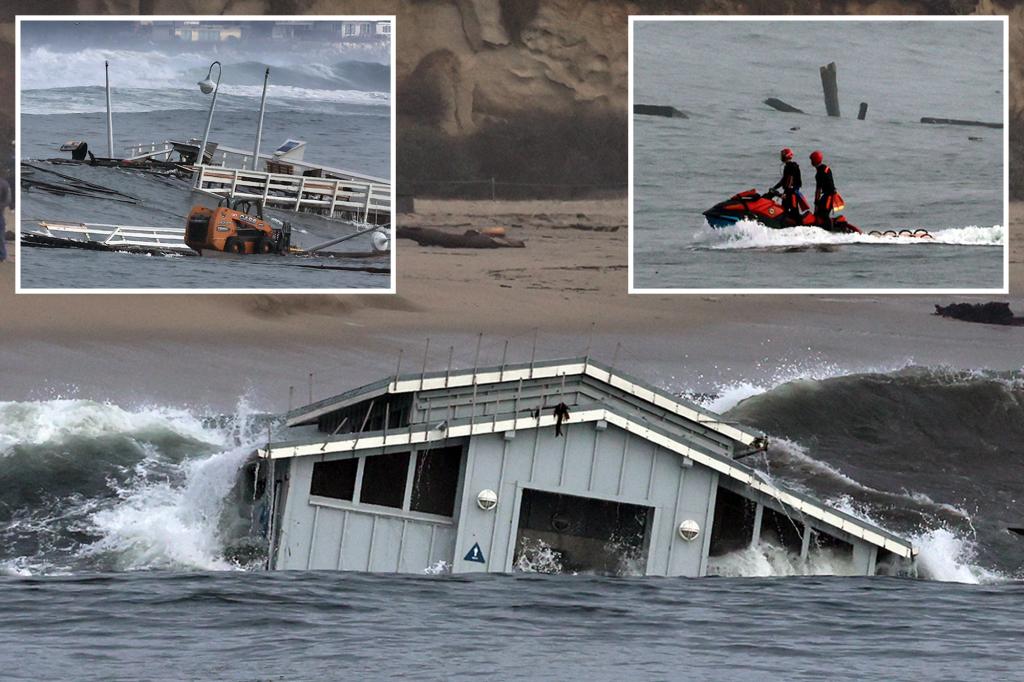The coastal city of Santa Cruz, California, faced the brunt of a powerful storm on Monday, January 9, 2024, resulting in the partial collapse of its iconic wharf and a tragic loss of life. The storm, marked by colossal waves reaching up to 60 feet, unleashed its fury on the already fragile pier, which had been undergoing renovations following damage from previous storms. Around 12:45 p.m., a 150-foot section at the end of the wharf succumbed to the relentless pounding of the waves, sweeping away a closed restaurant named The Dolphin, a restroom facility, and construction equipment involved in the ongoing renovation project. Dramatic footage and images captured the devastation, showing the restroom building toppled on the beach, the wrecked pier section floating amidst the turbulent waters, and debris scattered across the ocean’s surface.
Amidst the chaos of the collapsing wharf, three individuals were swept out to sea. Two of them were fortunate enough to be rescued by swift-acting rescue swimmers, while the third managed to self-rescue, reaching safety without external assistance. Santa Cruz Mayor Fred Keeley, while expressing relief at the rescues, issued a stern warning to the public, urging them to avoid the area and stay out of the water until further notice, emphasizing the inherent dangers posed by the storm’s aftermath.
The wharf, a beloved landmark and a vital part of Santa Cruz’s identity, suffered significant damage. Tony Elliott, the director of parks and recreation for the city, confirmed the closure of the wharf indefinitely pending a thorough structural assessment. This closure signifies not only a physical blow to the city’s infrastructure but also an economic impact on businesses and the community that rely on the wharf’s presence. The collapsed section of the pier had been closed since January 2024 due to the ongoing renovation project, but the extent of the storm damage now poses a more substantial and long-term challenge for the city.
The storm’s impact extended far beyond the Santa Cruz wharf, wreaking havoc along the Pacific coast of California. The National Weather Service’s Bay Area office reported extremely rough seas, with waves reaching astonishing heights of 60 feet, along with widespread flooding and damage. The sheer force of the storm highlighted the vulnerability of coastal communities to the increasingly volatile weather patterns impacting the region. The storm served as a stark reminder of the power of nature and the importance of preparedness in the face of such extreme events.
Tragically, the storm also claimed a life near Santa Cruz. At Sunset State Beach, a man was caught by a massive wave and trapped beneath debris, succumbing to the overwhelming force of nature. This heartbreaking incident underscores the real and immediate dangers associated with powerful storms and the need for caution in coastal areas, especially during periods of heightened weather activity. The combination of high waves, strong currents, and debris creates a hazardous environment that can quickly overwhelm even experienced swimmers and beachgoers.
The storm’s impact on Santa Cruz serves as a microcosm of the broader challenges faced by coastal communities around the world. Rising sea levels, more frequent and intense storms, and coastal erosion are increasingly threatening the infrastructure, economies, and very existence of these communities. The partial collapse of the Santa Cruz wharf stands as a stark reminder of the urgent need for climate adaptation and resilience measures to protect coastal communities from the escalating impacts of climate change. The event further emphasizes the necessity for continuous monitoring and maintenance of coastal infrastructure to ensure its ability to withstand the relentless forces of nature. The rebuilding process for the Santa Cruz wharf will undoubtedly be a significant undertaking, requiring not only financial resources but also a comprehensive assessment of the structural needs and the incorporation of resilient design principles to better withstand future storms. The storm also underscores the critical role of public awareness campaigns to educate residents and visitors about the potential dangers of coastal storms and the importance of adhering to safety guidelines, particularly during periods of heightened risk.

